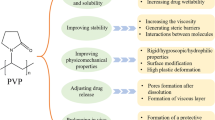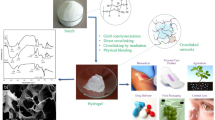Abstract
The current study involved the development of a novel sustained release crosslinked semi-IPN xerogel matrix tablet prepared by chemical crosslinking of poly(ethylene) oxide (PEO) and gellan gum (GG) employing epichlorohydrin (EPI) as crosslinker. A Box–Behnken design was employed for the statistical optimization of the matrix system to ascertain the ideal combination of native polymeric and crosslinking agents. Characterization studies were performed by employing standard polymer characterization techniques such as Fourier transform infrared spectrometry, differential scanning calorimetry, and scanning electron microscopy. Formulated matrix tablets displayed zero-order release kinetics, extending over 24 h. The mechanism of drug release was primarily by swelling and surface erosion. Crosslinked semi-IPN xerogel matrix tablets were compared to non-crosslinked polymer blends; results from the study conducted showed that the physiochemical properties of the PEO and GG were sufficiently modified to allow for sustained release of sulpiride with a 100% drug release at 24 h in a controlled manner as compared to non-crosslinked formulations which displayed further release beyond the test period. Crosslinked formulations displayed water uptake between 450 and 500% indicating a controlled rate of swelling and erosion allowing for sustained release. Surface morphology of the crosslinked system depicted a porous structure formed by interpenetrating networks of polymers, allowing for a greater degree of controlled penetration into the system affording it the ability to sustain drug release. Therefore, conclusively, based on the study performed, crosslinked PEO-GG allows for the sustained release of sulpiride from a hydrophilic semi-IPN xerogel matrix system.











Similar content being viewed by others
References
Dürig T, Fassihi R. Guar-based monolithic matrix systems: effect of ionizable and non-ionizable substances and excipients on gel dynamics and release kinetics. J Control Release. 2002;80:45–56.
Huang X, Brazel CS. On the importance and mechanisms of burst release in matrix-controlled drug delivery systems. J Control Release. 2001;73:121–36.
Tanaka N, Imai K, Okimoto K, Ueda S, Tokunaga Y, Ibuki R, et al. Development of novel sustained-release system, disintegration-controlled matrix tablet (DCMT) with solid dispersion granules of nilvadipine (II): In vivo evaluation. J Control Release. 2006;112:51–6.
Shanmugam S, Manavalan R, Venkappayya D, Sundaramoorthy K, Mounnissamy VM, Hemalatha S, et al. Natural polymers and their applications. Nat Prod Rad. 2005;4:478–81.
Kulkarni VS, Butte KD, Rathod SS. Natural Polymers - A Comprehensive Review. Int J Pharm Biomed Sci. 2012;3:1597–613.
Krishnaraj K, Chanrasekar MJN, Nanjan MJ, Muralidharan S, Manikandan D. Development of Sustained release antipsychotic tablets using novel polysaccharide isolated from Delonix regia seeds and its pharmacokinetic studies. Int J Pharm. 2012;20:239–48.
Singh A, Sharma PK, Malviya R. Release Behaviour of Drugs from various Natural Gums and Polymers. Polym Med. 2011;41:73–80.
Cappello B, DeRosa G, Giannini L. Cyclodextrin containing polyethylene oxide tablets for the delivery of poorly soluble drugs: Potential as buccal delivery system. Int J Pharm. 2006;319:63–70.
National Toxicology Program. Report on Carcinogens. 12th Edition, Department of Health and Human Services. 2011; 12:180.
Chiba R, Soukura M, Tatsuta S. Liquid Chromatography solid phase extraction and determination of Sulpiride in human serum by high performance liquid chromatography using electro generated chemiluminescence detection. Anal Lett. 2011;44:1559–69.
Barnes TRE, Davison S, Ferrier IN, et al. Consensus statement on high dose Anti-psychotic medication. Royal College of Psychiatrics. 2006;1-51.
Watanabe K, Sawano T, Terada K, Endo T, Sakata M, Sato J. Studies on Intestinal Absorption of Sulpiride (1): Carrier-Mediated Uptake of Sulpiride in the Human Intestinal Cell Line Caco-2. Biol Pharm Bull. 2002;25:885–90.
Sigma Aldrich, MDS (±) Sulpiride, Germany.
Covielloa T, Alhaiquea F, Parisia C, Matricardia P, Bocchinfusob G, Grassi M. A new polysaccharidic gel matrix for drug delivery: preparation and mechanical properties. J Control Release. 2005;102:643–56.
Choonara YE, Pillay V, Carmichael T, Danckwerts MP. An in vitro study of the design and development of a novel doughnut-shaped Minitab let for intraocular implantation. Int J Pharm. 2006;310:15–24.
Kreye F, Hamm G, Karrout Y, Legouffe R, Bonnel D, Siepmann F, et al. MALDI-TOF MS imaging of controlled release implants. J Control Release. 2012;161:98–108.
Scaccia S. Water determination in composite PEO-based polymer electrolytes by volumetric Karl Fischer titration method. Talanta. 2005;67:678–81.
Shah RB, Tawakkul MA, Khan MA. Comparative Evaluation of Flow for Pharmaceutical Powders and Granules. AAPS PharmSciTech. 2008;9:250–8.
Özeroglu C, Birdal A. Swelling properties of acrylamide-N, N′-methylene bis (acrylamide) hydrogels synthesized by using meso-2, 3-dimercaptosuccinic acid-cerium (IV) redox couple. Express Polym Lett. 2009;3:168–76.
Reddy MM, Reddy JD, Moin A, Shivakumar HG. Formulation of Sustained –Release Matrix Tablets using Crosslinked Karaya Gum. Trop J Pharm Res. 2012;11:28–35.
Murthy PSK, Mohan YM, Sreeramulu J, Raju KM. Semi IPNs of starch and poly (acrylamide-co-sodium methacrylate): Preparation, swelling and diffusion characteristics evaluation. J Reac Funct Polym. 2006;66:1482–93.
Strübing S, Metz H, Mäder K. Characterization of poly (vinyl acetate) based floating matrix tablets. J Control Release. 2008;126:149–55.
Pillay V, Fassihi R. A novel approach for constant rate delivery of highly soluble bioactives from a simple monolithic system. J Control Release. 2000;67:67–78.
Ruvalcaba AM, Snchez-Diaz JC, Becerra F, Cruz-Barba LE, Gonzalez-Alvarez A. Swelling characterization and drug delivery kinetics of polyacrylamide-co-itaconic acid/chitosan hydrogels. Express Polym Lett. 2009;3:25–32.
Khalid MN, Agnely F, Yagoubi N, Grossiord JL, Couarraze G. Water state characterization, swelling behaviour, thermal and mechanical properties of chitosan based networks. Eur J Pharm Sci. 2002;15:425–32.
Aulton ME. The Design and Manufacture of Medicines. Third Edition. Philadelphia. Elsevier. 2007;109–110.
Ferrero C, Massuelle D, Deolker E. Towards elucidation of the drug release mechanism from compressed hydrophilic matrices made of cellulose ether. II Evaluation of a possible swelling-controlled drug release mechanism using dimensionless analysis. J Control Release. 2010;141:223–33.
Ahuja G, Pathak K. Porous carriers for controlled/modulated drug delivery. Ind J Pharm Sci. 2009;71:599–607.
Sriamornsak P, Thirawong N, Weerapol Y, Nunthanid J. Swelling and Erosion of pectin Matrix tablets and their impact on drug release behaviour. Eur J Pharm Biopharm. 2007;7:211–9.
Kulkarni RV, Baraskar VV, Setty CM, Sa B. Interpenetrating Polymer Network Matrices of Sodium Alginate and Carrageenan for Controlled drug delivery application. J Fibres Polym. 2011;12:352–8.
Kulkarni RV, Mangond BS, Mutalik S, Sa B. Interpenetrating polymer network microcapsules of gellan gum and egg albumin entrapped with diltiazem–resin complex for controlled release application. Carb Polym. 2011;83:1001–7.
Rokhade AP, Agnihotri SA, Patil SA, Malikarjuna NN, Kulkarni PV, Aminabhavi TM. Semi- Interpenetrating polymer network microspheres of gelatin and sodium Carboxymethyl cellulose for controlled release of ketorolac tromethamine. Carb Polym. 2006;65:243–52.
Szakonyi G, Zelkó R. The effect of water on the solid state characteristics of pharmaceutical excipients: Molecular mechanisms, measurement techniques, and quality aspects of final dosage form. Int J Pharm Invest. 2012;2:18–25.
Ibrahim S, Johan MR. Thermolysis and Conductivity Studies of Poly (Ethylene Oxide) (PEO) Based Polymer Electrolytes Doped with Carbon Nanotube. Int J Electrochem Sci. 2012;7:2596–615.
Izumi Y, Saito S, Soma K. Differential Scanning Calorimetry and Structural studies of the sol-gel transition of gellan gum in water. Progress Colloid Polym Sci. 1999;114:48–55.
Zo-li JTU. Morphology, Crystallization and Melting Behavior of Propylene-Ethylene Statistical Copolymers. Doctor of Philosophy. Virginia: Polytechnic Institute and State University. 2005;3–29.
UserCom, 1/2000, Information for users of METTLER TORLEDO thermal analysis systems, Mettler Toledo. 2000;1–25.
Reis MD, Pruitt L. Effects of cross-linking on the microstructure and mechanical properties of ultra- high molecular weight. Clin Orthopedic Res. 2005;440:149–56.
Coates J. Interpretation of Infrared Spectra, A Practical Approach. In. Encyclopedia of Analytical Chemistry. R.A. Meyers (Ed.) 2000; pp. 10815–10837.
Adel AM, Abou-Youssef H, El Gendy AA, Nada AM. Carboxymethylated Cellulose Hydrogel Sorption, Behaviour, and Characterization. Nature Sci. 2010;8:244–56.
Gulrez SKH, Al-Assaf S, Phillips GO. Hydrogels: Methods of Preparation, characterization and Applications. In. Progress in Molecular and Environmental Bioengineering - From Analysis and Modeling to Technology Applications. A. Carpi (Ed.) 2011; pp. 307–568.
Toti US, Aminabhavi TM. Modified guar gum matrix tablet for controlled release of diltiazem hydrochloride. J Control Release. 2004;95:567–77.
Maderuelo C, Zarzuelo A, Lanao JM. Critical factors in the release of drugs from sustained release hydrophilic matrices. J Control Release. 2011;154:2–19.
Siepmann J, Lecomte F, Bodmeie R. Diffusion- controlled drug delivery systems: calculation of the required composition to achieve desired release profiles. J Control Release. 1999;60:379–89.
Siepmann J, Peppas NA. Modeling of drug release from delivery systems based on hydroxypropyl methylcellulose (HPMC). J Adv Drug Del Rev. 2012;64:163–74.
Shoaib MH, Tazeen J, Merchant HA, Yousuf RI. Evaluation Of Drug Release Kinetics From Ibuprofen Matrix Tablets Using HPMC. Pak J Pharm Sci. 2006;19:119–24.
Reddy KR, Mutalik S, Reddy S. Once-Daily Sustained-Release Matrix Tablets of Nicorandil: Formulation and In Vitro Evaluation. AAPS PharmSciTech. 2003;4:1–9.
Acknowledgements
This study was funded by the National Research Foundation (NRF) of South Africa.
Conflict on Interest
The Authors declare that there are no conflicts of interest.
Author information
Authors and Affiliations
Corresponding author
Rights and permissions
About this article
Cite this article
Hoosain, F.G., Choonara, Y.E., Kumar, P. et al. An Epichlorohydrin-Crosslinked Semi-Interpenetrating GG-PEO Network as a Xerogel Matrix for Sustained Release of Sulpiride. AAPS PharmSciTech 15, 1292–1306 (2014). https://doi.org/10.1208/s12249-014-0153-4
Received:
Accepted:
Published:
Issue Date:
DOI: https://doi.org/10.1208/s12249-014-0153-4




